The 19th bread in the Bread Baker’s Apprentice Challenge is Marbled Rye Bread.
I wasn’t really a big fan of rye bread until I started making it myself. I still prefer breads made with wheat, but I do enjoy a good rye loaf every now and then.
Chris at eating is the hard part had mentioned on Twitter that the BBA Rye Loaves were different and would convert me so I was looking forward to trying them. I agree with his assessment. These marbled loaves are beautiful and taste great!
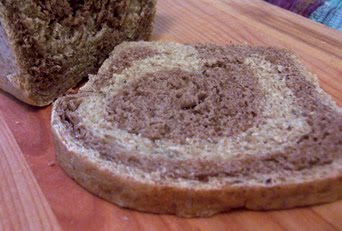
I enjoyed making this rye bread. I thought it might be tricky working with the different colored pieces of dough, but it wasn’t. It was actually very easy!
Peter Reinhart simplifies the process by shaping the pieces into batards, then into loaves so it turned out to be a very creative and relaxing process.
To make things even easier, this version utilizes the direct dough method, as opposed to the sourdough method that is generally used for onion rye and deli rye. So, this bread can be made in an evening if you plan it right.
Interesting facts about Rye
Rye is hardier than wheat, resistant to cold, and is the only grain other than wheat that can be used to make leavened bread. It can be made into a sweet or sour loaf.
Rye is high in B vitamins, especially niacin. It contains iron, zinc, and magnesium as well as vitamin E, rutin, antioxidants, and insoluble fiber. It has a bitter-strong, earthy flavor with a pleasant aftertaste.
It can be used alone in a loaf or mixed with cornmeal, potato, white flour or whole wheat. Without the addition of wheat flour for body, rye makes a flat, crumbly, and coarse-grained loaf.
Marbled Rye Bread
Makes:
2 loaves
Adapted from: The Bread Baker’s Apprentice by Peter Reinhart
Marbled Rye Bread is typically made with a combination of light and dark rye dough. The formula suggested using white rye flour, but I didn’t have any so I used stone-ground whole grain rye flour instead.
Whole grain rye flour makes a more rustic-looking bread than the creamy-colored version you get when using white rye flour. However, the whole grain version has more nutrients because it retains the bran and germ; whereas white rye flour has been sifted twice to remove the bran and germ.
I prepared each dough (almost) simultaneously so they would rise at about the same time.
Whole Grain Rye:
- 1 1/2 cups stone-ground whole grain rye flour (or white rye flour)
- 3 cups unbleached bread flour or clear flour
- 1 1/2 teaspoons salt
- 1 3/4 teaspoons instant yeast
- 1 1/2 teaspoons caraway seeds (optional)
- 1 tablespoon molasses
- 2 tablespoons shortening
- About 1 1/4 cups plus 2 tablespoons water, at room temperature
Dark Rye
:
- 1 1/2 cups stone-ground whole grain rye flour (or white rye flour)
- 3 cups unbleached bread flour or clear flour
- 1 1/2 teaspoons salt
- 1 3/4 teaspoons instant yeast
- 1 1/2 teaspoons caraway seeds (optional)
- 1 tablespoon molasses
- 2 tablespoons shortening
- About 1 1/4 cups plus 2 tablespoons water, at room temperature
- 1 tablespoon liquid caramel coloring or
- 2 tablespoons cocoa, carob, or coffee powder dissolved in 2 tablespoons (1 ounce water) (I used cocoa powder)
Egg Wash
:
- 1 egg, whisked with 1 teaspoon water until frothy.
Prepare the Light Rye Dough:
I mixed the dough by hand, but you can use a stand mixer if preferred.
Stir together the dry ingredients, including the caraway seeds. Add the molasses, shortening, and water. Mix until the dough forms a ball. Add additional water if needed.
Transfer the dough to a work surface lightly sprinkled with flour. Knead for about 4 minutes by hand. Add sprinkles of flour if necessary.
The dough should feel supple and pliable, a little tacky but not sticky. Transfer the dough to a lightly oiled bowl and roll it around to coat it. Then cover and let it rest.
Prepare the Dark Rye Dough:
Stir together the dry ingredients, including the caraway seeds. Add the molasses, shortening, water, and liquid caramel coloring.
I used a mixture of cocoa and water for the caramel coloring. When I make this again, I think I’ll try coffee granules to make it a little bit darker.
Mix until the dough forms a ball. Add additional water if needed.
Transfer the dough to a work surface lightly sprinkled with flour. Knead for about 4 minutes by hand. Add sprinkles of flour if necessary.
The dough should feel supple and pliable, a little tacky but not sticky. Transfer the dough to a lightly oiled bowl and roll it around in it to coat it. Cover and let it rest.
Bulk Ferment:
Ferment the dough at room temperature for about 90 minutes, or until each dough doubles in size.
Shape the Loaves:
Turn one dough at a time out onto a lightly floured work surface. Divide each dough into 4 even-sized pieces using a dough scraper.
Using a rolling pin, roll out each piece into an oblong about 5 inches wide and 8 inches long.
To make a spiral loaf, which is what I chose to do, take a light rye piece and lay a dark rye piece on top, then add a light rye piece, then one more dark rye piece.
Roll this stack up into a batard (torpedo shape) and seal the bottom.
Repeat with the remaining dough to make two loaves. Then, place each loaf in an greased 8 1/2 x 4 1/2-inch loaf pans. You can also bake these loaves freeform on a baking sheet, but I wanted a beautiful sandwich loaf so I used loaf pans.
It was fun watching the loaves proof. A benefit of using glass pans is that you can see what the spirals look like from the side.
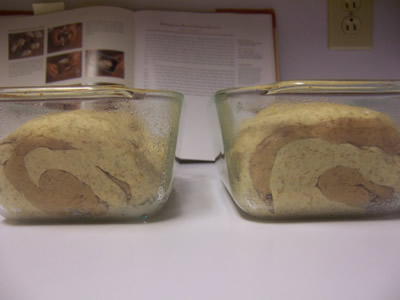
Proof the Loaves:
Mist the loaves with spray oil and cover loosely with plastic wrap. Proof at room temperature for 60 to 90 minutes, or until the loaves double in size. Depending on the temperature in your kitchen, it may take less than an hour for the loaves to fully proof.
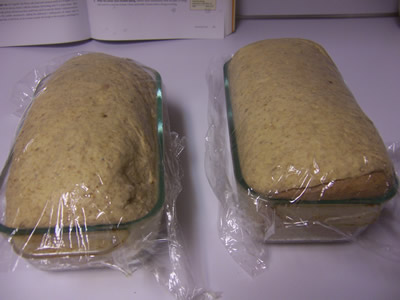
Bake the Loaves:
Preheat the oven to 350 degrees with the oven rack on the middle shelf. Prepare the egg wash by whisking together the egg and water until frothy. Brush the loaves evenly, but gently with the egg wash.
Bake the loaves for approximately 45 minutes. Rotate the loaves after 20 minutes if necessary for even baking. The loaves should make a hollow sound when thumped on the bottom.
The loaves are done when they register 190 degrees on a thermometer. Another way to check for doneness is to thump the loaves on the bottom. If they sound hollow, they are ready.
Remove the loaves immediately from the pan when they have finished baking and let them cool on a wire rack for at least 1 hour, preferably 2 hours, before serving or slicing.
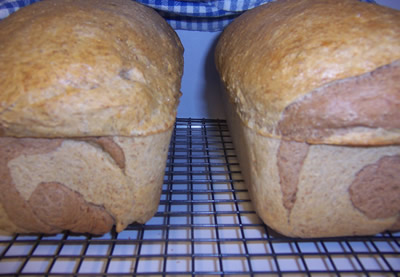
I enjoyed this bread toasted the next morning with some homemade citrus marmalade.
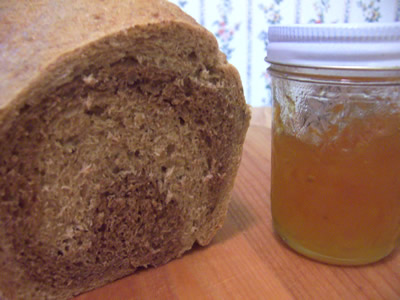
Thank you for joining us in the Bread Baker’s Apprentice Challenge. See you next time…
Happy Baking!
Cathy
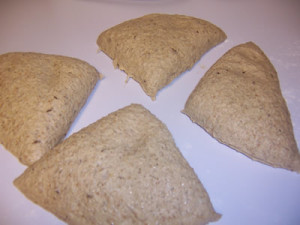
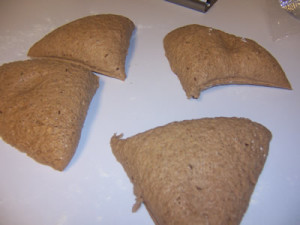
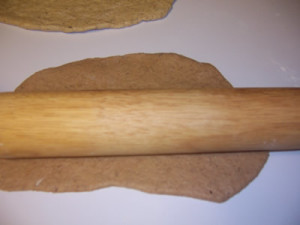
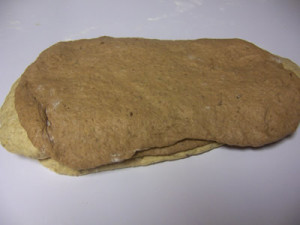
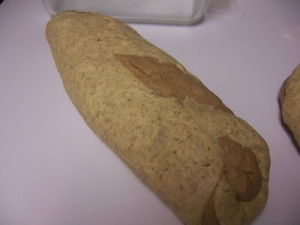
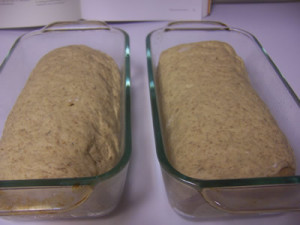
Frieda says
Awesome! I liked how you could see the spirals through the glass…
I omitted the caraway seeds and put 1 T. of McCormick’s caramel coloring and got a very dark rye. Did you use a different brand of caramel color?
Just posted my rye bread…
Cathy (breadexperience) says
I used cocoa powder mixed with water instead of the caramel coloring. Next time I think I’ll try coffee granuals mixed with water to make it darker.
I don’t always like caraway seeds but they taste really great in this version!
gaaarp says
Great job, Cathy! And your post is awesome — very thorough, easy to follown, and lots of great pictures.
I’m making this bread this weekend, and I can’t wait!!
Cathy (breadexperience) says
Thanks Phyl! I really enjoyed making this one! I look forward to your post.
Alyssa says
Thanks for sending this to the BYOB roundup! The bread turned out beautifully. I’m really interested in your comments regarding liking rye. I love it, but my husband doesn’t. So I’ve been a bit concerned about getting to the rye breads.
P.S. Thanks for stopping by my blog.
Cathy (breadexperience) says
Hi Alyssa! Thanks for stopping by. Tell your husband this rye bread is worth trying. It’s not as strong as other rye breads. Also, it might be the caraway seeds that he doesn’t like so you can just omit them.
I have some other rye bread recipes you might enjoy https://www.breadexperience.com/rye-bread-recipes.html. I especially enjoyed the honey and beer rye bread. You make the dough in your bread machine and bake it free form. Can’t beat that for simplicity.